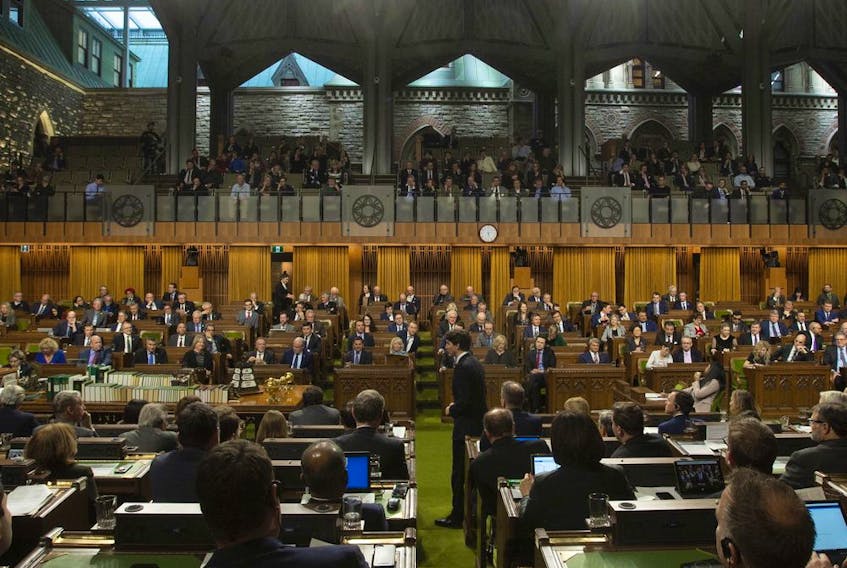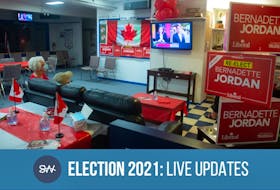A political party must win 170 of the total 338 seats to win a majority in the House of Commons.
That ensures the governing party can pass legislation and implement its promises and mandates regardless of whether Opposition parties object.
But with polls suggesting no political party seems in a position to capture a majority, it appears Canadians will soon have either a minority Conservative or minority Liberal government, propped up by one or a combination of other federal parties.
Minority-led governments are not an uncommon scenario in Canadian Federal politics.
Former Liberal prime minister Paul Martin entered the 2004 federal election with a majority government, then lost his majority in that race.
In that case, the Martin Liberals didn’t rely on negotiated support from Opposition parties, opting instead to obtain majority consent in Parliament for legislation on an ad hoc, case-by-case basis.
Other prime ministers who in one way or another governed with minorities include Stephen Harper, Joe Clark, Pierre Trudeau, John Diefenbaker, Arthur Meighen, William Lyon Mackenzie King and Alexander Mackenzie.
With all that in mind, here are four scenarios to help explain what our government could look like in the wake of Monday’s election.
Scenario 1: Someone wins a majority
While the polls suggest it’s unlikely, the simplest scenario is a Parliamentary majority.
Here’s how that would work.
Any party that manages to elect at least 170 Mmembers of parliament from Canada’s 338 electoral ridings wins power.
Should Justin Trudeau’s Liberals manage 170 or more seats, the Liberals would remain in power and Trudeau would remain prime minister.
Should Andrew Scheer’s Conservative MPs take 170 or more seats, Trudeau would concede defeat, which signals to the Governor General that the PM is ready to be dismissed and take on a caretaker role during a brief transition period.
Following those formalities, the incoming prime minister would assume office and make a Throne Speech declaring the plans and intentions of the new government, which would win support from their majority caucus.
Scenario 2: A minority government where Liberals win the most seats
If the Liberals win the most seats in the election and have a minority, Liberal Leader Trudeau would continue to serve as prime minister.
Trudeau will assess the state of his cabinet after the election. Some cabinet ministers may have lost their seats during the election so a cabinet shuffle would likely occur.
Scenario 3: A minority government where the Conservatives win the most seats with a large gap
If Andrew Scheer’s Conservatives win a minority government but the number of seats separating their victory from the Liberals is large — say 10 to 15 or more — then it is unlikely Trudeau would break tradition and try to form government with the cooperation of other parties like the NDP and Green Party.
In this case, the Conservatives might try to work with the Bloc Québécois to get the seats they need for a majority to pass the House vote of confidence, or some combination of other parties.
However, according to Nelson Wiseman, a professor at the University of Toronto’s Department of Political Science, if the Conservatives can’t woo the Bloc — and he suggests “the Bloc isn’t interested in joining anybody” — then Trudeau’s Liberals may try to hold onto power.
Wiseman said minority governments last an average of 18 to 24 months.
Scenario 4: A minority government where the Conservatives win the most seats with a small gap
If Andrew Scheer and the Conservatives win a minority government, but the number of seats separating their victory from the Liberals is small — say five or less — then the Liberals could also remain in power.
It is important to remember that with minority governments, the party that wins the most seats does not automatically get to form government.
The PM, in this case, could decide the Conservative’s mandate is weak and try to secure the confidence of the house.
This scenario would involve cooperation between the Liberals and other parties.
For instance, even though the Conservatives won the most seats, the Liberals, working with the NDP, could secure enough votes to pass a vote of confidence and keep Trudeau in the office of the Prime Minister.
The cooperation between the Liberals and NDP could take several forms: A formal coalition, a confidence-and-supply agreement, or as previous minority governments have done, work with other parties on a case-by-case basis.
In that instance, Canada’s Governor-General, who is the Queen’s representative in our Parliamentary democracy, would be called upon to determine which party had the best chance to form a government and actually govern.
“The job of the Governor General is to make sure there is a government and to stay out of this,” Wiseman said.
RECENT CANADIAN MINORITY GOVERNMENTS AT A GLANCE:
1963: The Liberals won power with 128 seats under leader Lester B. Pearson, leading Diefenbaker to resign. Pearson’s minority, propped up by the NDP, lasted 18 months and a second minority following the 1965 election lasted just over two-and-a-half years.
1979: The Conservatives, led by Joe Clark, defeated the Liberals and Pierre Elliot Trudeau — winning a minority government with 136 seats. The Liberals did win the popular vote and Clark’s minority government lasted less than a year before another election was called in 1980 where the Trudeau Liberals won a majority.
2004: Paul Martin’s Liberal government won 135 seats, ending a streak of three consecutive Liberal majorities. Martin’s minority fell within 16 months.
2006: Stephen Harper and the Conservatives won the 2006 election with 124 seats, defeating the Paul Martin’s Liberals who won 103 seats.
Copyright Postmedia Network Inc., 2019


